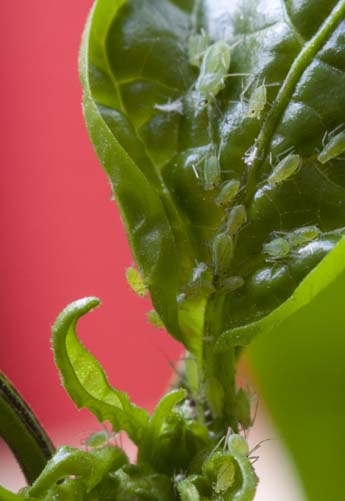About a week ago i noticed that one of my plants (an orange habanero) was infested with aphids.

Aphids (sometimes called green plant lice) are small (usually, though they can vary in size quite a bit) green insects that feed on plants mainly in temperate regions. They quickly multiply and can be very destructive, usually feeding on regions of new growth on plants.
To the right is a picture I took of the habanero plant in question. You can see that the aphids are focused mainly on the areas of new growth. I’ve found in the past that they simply demolish the new leaves/flowers as they emerge and if left to do this they’ll eventually kill the plant.
Getting Rid of Aphids – Tips & Tricks
Spraying your plants with a weak soap water solution to remove/deter aphids can work well. However I don’t like using this technique too often on edible plants. It can also leave your plants with a stick white residue from the soap suds.
Using insecticides to kill aphids will also kill the predators that eat the aphids. This means you’ve only got a short term solution to the problem.
This year I decided that i would opt for a much more natural approach to my aphid control. I tried to attract the natural predators of aphids which include ladybirds, hover-fly and crab spiders amongst others.
Natural Solutions To Aphids
Much has been been made in the press recently about the invasion of harlequin ladybirds and how they are putting many species of insects at risk of extinction. Well the good news for us chili heads is that ladybirds are the number one predator of aphids.
So your number one strategy should be to attract more ladybirds. Believe it or not the easiest way to get more ladybirds onto your chillie plants is to simply buy ladybirds via the internet! I did this a couple of weeks ago and have had great success. I simply put the infected plant into the greenhouse and released the lady birds inside. Within two days the problem was gone!
Of course there is no guarantee that the ladybirds will stick around once they have no aphids left to eat.
Long Term Aphid Solutions
A longer term prevention strategy that has proved very effective to a good friend of mine is to buy a ladybird tower which provides any passing ladybirds with a ready made home in which to nest, ensuring you have an on site population of aphid munching beasts.
I’ve bought one of these little contraptions and placed it in the garden. After a few weeks ladybirds moved in and regularly inhabit it. This means my garden is likely to have more aphid predators than before.






today i used a flea bomb in my poly tunnel ,only a small one …came back 10 mins later to find the soil in the pots directly under my chocolate bhut jolokias and reapers was carpeted with dead/dying greenflys defo worked but must see tomorrow how the plants took it.they were ok 6 hours fter i did it… i hope it works without plat suffering cos it s only £6 for 2 cans on amazon and worked in minutes….dont know what else it killed tho…soon see tmoz
ryan – sounds promising…i’d be interested to hear in a few days how the plants held up and if the infestation was cleared!
This is the first time I’d heard of a ladybird tower. We get bursts of aphids in our gardens as well, but have found the following to work. We bordered our pepper plants with fennel (to the north so as not to block sunlight), and we included lupines elsewhere in the garden. Lupines seem to attract aphids by the hundreds, seemingly keeping them off nearby plants. The fennel flowers attract all kinds of bee and predatory wasp species, as well as ladybugs which bred on the fennel plants all season. Much easier than manually spraying plant by plant.
Thanks for the tips!
Well, I just discovered what aphids are. I saw bunch of white sticky stuff with larvae…and bunch of ants protecting it. I will try some of the methods here. Thanks for sharing.
Having grown many, many plants in Spain, the best treatment I have found for Red Spider Mite and probably other pests is Neem Oil. Easily obtained on Ebay or Amazon.
Hey Guys, I do have a same problem.. Today I saw a lots of aphids on my chilly plants. I wash them with water but I am afraid they will come again 🙁 I would also like to use the spray of water, dishwasher liquid, chilly power and Tabasco as some of the friends told that it helps. Is there any specific dishwasher liquid or any dishwasher liquid can be used?? Plz suggest me
Sima,
Any washing liquid that you use in the kitchen will do!
I have used crushed tomato leaves with garlic chilli and soap in the past, with great success. Tomato leaves as we know are poisonous and combined with garlic and chilli is a great option.
Someone suggested tobasco sauce which I think is a fantastic idea – shall try and see how i go!
I noticed aphids on my chilli plant today and made a mixture of water / store bought dishwashing liquid , cayenne pepper and quite a few drop of tobasco sauce – put it in a small spray bottle and sprayed the plant – in maybe half an hour they were all dead and i washed the plant with a garden hose –
Andrew,
I’ve never tried tobasco as a tool to get rid of aphids…glad to hear it worked! Maybe i’ll give it a go this spring!
I have a habanero pepper plant. It had the aphids. I made they spray w dawn dish soap and water. Now the bugs are gone but all the leaves are falling off. What can I do now!
Andrea,
That’s strange. Try rinsing the plant with a water spray. Hopefully you solved the bug problem in time and the new growth should come back soon.
Hi @Andrea,
The leaves are falling off because you may have putted too much dish soap. On need to worry leaves will grow again. Just make sure to mix right quantity of soap next time.
Regards,
Balconygardenweb.com
The eadyiest way to get rid of aphibs iis to put your plants outside and
Nature will kill the aphids ,ants ladybirds and parasite wasps
well I had an attack of the greenfly on my 3 cayenne chilli plants that I keep in the front porch. It acts as a greenhouse and gets the sun most of the day. I was struggling to contain the little critters until my granddaughter said that I should put some ladybirds on the plants and promptly collected 2 or 3 from the back garden.Whoosh they went through the aphids very quickly as they are voracious feeders and within 2-3 days the aphids were gone. The leaves began to look a lot healthier although it took several months for them to become green and healthy again. I would advise anybody who uses ladybirds as a pest control for aphids to use them in a confined space , (greenhouse or porch etc) as this stops the ladybirds from flying away too soon , and if the aphids come back just get some more ladybirds in. I believe they also eat the eggs as well.
I have used a garlic spray in the past, heating a number of crushed cloves in a saucepan of water, sieving out the garlic and putting the resulting ‘garlic soup’ in a spray. Maybe it works best if only one of the breeding pair has the garlic?
I’ve heard Eucalyptus is a good organic pesticide, spraying the plant with a mixture of water and oil when infested but I’m wondering if an actual plant in the greenhouse would deter the pests. Might be something to look into.
I second Sean’s suggestion. Marigolds work and really brighten up the place so it’s win win…
Try using Marigold flowers too…they are known to attract Aphids & keep pests @ bay…
I’m so pleased to have found your website, it has given me lots of info that I have been needing!This is my first chilli growing experience and I’m loving it! I’m very protective of my plants and was mortified to find the dreaded Red Sider Mite had infested most of them, but with persistant water spraying to create a humid condition, which apparently slows the breeding process (and trimming off infected leaves) I have so far (fingers and toes crossed!) kept them at bay. I have now 31 chillies on 7 plants and am nearing my first harvest. I do have a question however, I only have one perfectly red chilli among all the rest green….will they all turn red eventually or should I go ahead and harvest them green?
Lynne Sara – Glad you like the site. With regards to ripeness much depends on what varieties you are growing. some mature green, other yellow and others red. What variety are you growing?
My chili seedlings have fallen victim to aphids and i’m now wondering if I should continue to nurse them or start over. They are SLOWLY getting their 2nd leaves and some still bare their seed shells. (planted May 26ish). I’d like to save these as a good friend gave them to me.
Athena – I’d try both if i were you. Aphid damage can cause your plants growth to be stunted. I’d maybe get some more seeds in quick as a back up!
Whitle oil works well and does not leave a bad taste on the fruit.
I’ve been reading that nasturtiums are good for this. Aphids love them, so if you plant a bed of nasturtium flowers away from the plants you want to protect, they are supposed to go to the nasturtiums instead.
GP – I have never tried this type of ‘sacrificial’ planting for fear I am just attracting pests that might otherwise have passed my plants by. I may give it a go however as I have heard of others having success with it.
i must admit i have not tried this method. i have heard of other people treating aphid infestations with a chilli pepper tea solution. i’ll definitely give it a go this year.
has anybody else out there tried this method?
Have you tried making a tea with some of your peppers?Grind them, boil them in water, strain, then spray your plants. This should help control the problem.
I have had an invasion attack of mega proportion on my chillies. I am growing chillies in my garden in Durban South Africa and just seems the right temperature that aphids love. I have snipped off affected areas of the plant which eradicates them for a while but then a couple of weeks later and they are back. I am busy with spraying a soap solution but still haven\\\\\\\\\\\\\\\’t eradicated them. Disappointing as my chillies were growing like wild fire until the aphids arrived. Now out of 30 plants i have I have only produced one chilli.
I dont really want to get insecticides and although there are lady birds around they dont realise there is enough food here. http://kelbyschillies.blogspot.com
the product(in the link) will never let you down when it comes to controlling aphids on your pepper plants.It is also natural and can be applied up to the day of harvest. I use this for many pest problems in my garden.
holes on the leaves would indicate slugs or snails to me. Try taking a look at our pests and diseases section for some tips to combat these pests!
I\’ve stuck all my plants out side now and they are doing ok apart from the holes in the leaves, I do hate those horrible little fly things, I wish I had a greenhouse!
Nice blog entry! I fully agree with you on the use of pesticides as I’ve had some bad experiences with Confidor killing everything it touches – including the good guys. Spider mites then moved in, and they’re a lot harder to get rid of too!
Regarding soap spray, I’ve had some good success with the Organic “green choice” dishwashing soap from Coles. It’s fully biodegradable so I’m not too worried about it getting into the soil either…
Unfortunately, “biological control agents” don’t work too well once the pests have had time to establish themselves and are present in great numbers. I have had only limited success with lacewing larvae as their growth and generational cycle is quite slow, so you need at least 2 generations for them to really be effective, so it’s good to establish a population to safeguard the garden rather than in reaction to an outbreak.
Culling aphids with soap before releasing any predators should also work well as soap spray will only kill those insects it covers – it doesn’t hang around and poison insects which come along after the soap has dried…